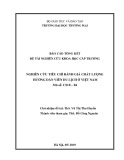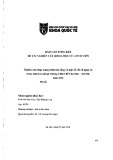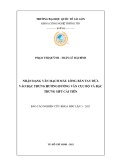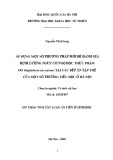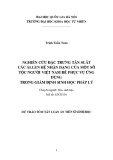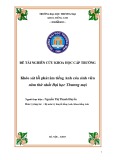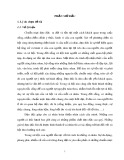
Open Access
Available online http://ccforum.com/content/9/3/R238
R238
Vol 9 No 3
Research
Effect of ventilator-associated tracheobronchitis on outcome in
patients without chronic respiratory failure: a case–control study
Saad Nseir1, Christophe Di Pompeo2, Stéphane Soubrier1, Hélène Lenci3, Pierre Delour3,
Thierry Onimus1, Fabienne Saulnier1, Daniel Mathieu3 and Alain Durocher1
1Intensive Care Unit, Calmette Hospital, Regional University Centre, and Medical Assessment Laboratory, EA 3614, Lille II University, Lille, France
2Medical Assessment Laboratory, EA 3614, Lille II University, Lille, France
3Intensive Care Unit, Calmette Hospital, Regional University Centre, Lille, France
Corresponding author: Saad Nseir, s-nseir@chru-lille.fr
Received: 26 Oct 2004 Revisions requested: 9 Feb 2005 Revisions received: 16 Feb 2005 Accepted: 24 Feb 2005 Published: 31 Mar 2005
Critical Care 2005, 9:R238-R245 (DOI 10.1186/cc3508)
This article is online at: http://ccforum.com/content/9/3/R238
© 2005 Nseir et al.; licensee BioMed Central Ltd.
This is an Open Access article distributed under the terms of the Creative Commons Attribution License (http://creativecommons.org/licenses/by/
2.0), which permits unrestricted use, distribution, and reproduction in any medium, provided the original work is properly cited.
Abstract
Introduction Our objective was to determine the effect of
ventilator-associated tracheobronchitis (VAT) on outcome in
patients without chronic respiratory failure.
Methods This was a retrospective observational matched study,
conducted in a 30-bed intensive care unit (ICU). All
immunocompetent, nontrauma, ventilated patients without
chronic respiratory failure admitted over a 6.5-year period were
included. Data were collected prospectively. Patients with
nosocomial pneumonia, either before or after VAT, were
excluded. Only first episodes of VAT occurring more than 48
hours after initiation of mechanical ventilation were studied. Six
criteria were used to match cases with controls, including
duration of mechanical ventilation before VAT. Cases were
compared with controls using McNemar's test and Wilcoxon
signed-rank test for qualitative and quantitative variables,
respectively. Variables associated with a duration of mechanical
ventilation longer than median were identified using univariate
and multivariate analyses.
Results Using the six criteria, it was possible to match 55 (87%)
of the VAT patients (cases) with non-VAT patients (controls).
Pseudomonas aeruginosa was the most frequently isolated
bacteria (34%). Although mortality rates were similar between
cases and controls (29% versus 36%; P = 0.29), the median
duration of mechanical ventilation (17 days [range 3–95 days]
versus 8 [3–61 days]; P < 0.001) and ICU stay (24 days [range
5–95 days] versus 12 [4–74] days; P < 0.001) were longer in
cases than in controls. Renal failure (odds ratio [OR] = 4.9, 95%
confidence interval [CI] = 1.6–14.6; P = 0.004), tracheostomy
(OR = 4, 95% CI = 1.1–14.5; P = 0.032), and VAT (OR = 3.5,
95% CI = 1.5–8.3; P = 0.004) were independently associated
with duration of mechanical ventilation longer than median.
Conclusion VAT is associated with longer durations of
mechanical ventilation and ICU stay in patients not suffering
from chronic respiratory failure.
Introduction
Nosocomial lower respiratory tract infections are the most
common nosocomial infections in the intensive care unit (ICU)
[1]. Although several studies have investigated nosocomial
pneumonia, few evaluated ventilator-associated tracheobron-
chitis (VAT).
VAT is a common nosocomial infection among mechanically
ventilated patients. VAT rates of 3.7–10.6% have been
reported in the literature [2-4]. In a previous descriptive pro-
spective cohort study conducted in 2128 patients [4], our
group demonstrated that VAT was associated with increased
durations of mechanical ventilation and ICU stay. However,
two major limitations of the study prevented us from drawing
definite conclusions: absence of adjustment for duration of
mechanical ventilation before the occurrence of VAT; and
inclusion of patients with and patients without chronic respira-
tory failure. Therefore, we performed a retrospective case–
control study to assess the effect of VAT on outcomes in
patients without chronic respiratory failure.
ICU = intensive care unit; VAP = ventilator-associated pneumonia; VAT = ventilator-associated tracheobronchitis.

Critical Care Vol 9 No 3 Nseir et al.
R239
Methods
This retrospective case–control study was conducted in our
30-bed ICU from March 1993 to September 1999. Because
it was observational, institutional review board approval was
not required, which is in accordance with institutional review
board regulations.
All immunocompetent, nontrauma patients without chronic
respiratory failure who were intubated and ventilated for more
than 48 hours were eligible. Patients with chronic respiratory
failure, trauma patients, patients who were not ventilated or
ventilated for less than 48 hours, patients who received only
noninvasive pressure ventilation, patients with tracheostomy at
ICU admission and immunocompromised patients were not
eligible. Patients who developed nosocomial pneumonia,
before or after the occurrence of VAT, were excluded. The
patients included in the present study were also included in
our previous prospective observational study of VAT [4], rep-
resenting 5% of the 2128 patients included in the previous
study.
Patients were intubated via either the oral or the nasal route,
according to clinical status and preference of the physician in
charge. The oropharyngeal cavity was cleaned four times daily
with chlorhexidine solution. Continuous subglottic suctioning
was not utilized. The ventilator circuit was not changed rou-
tinely. In all patients a heat–moisture exchanger was posi-
tioned between the Y-piece and the patient; the heat–
moisture exchangers were changed every 48 hours, or more
frequently if they were visibly soiled. No patient received
inhaled antibiotics. Patients were kept in a semirecumbent
position during most of their period of mechanical ventilation.
Sedation and weaning procedures were done at the discretion
of the physician in charge. No systematic stress ulcer prophy-
laxis and no selective digestive decontamination was given.
Tracheal aspiration was performed by nurses every 3 hours
and whenever necessary.
Throughout the study, endotracheal aspirates for quantitative
bacterial cultures were obtained routinely on admission,
weekly thereafter, and whenever VAT or ventilator-associated
pneumonia (VAP) was suspected. Antimicrobial therapy for
VAT was at discretion of the physician in charge.
All data were collected prospectively. VAT episodes were
identified by prospective surveillance of nosocomial infections.
Only first episodes of VAT occurring more than 48 hours after
initiation of mechanical ventilation were included. 'Cases' are
VAT patients, and 'controls' are patients without VAT. Trache-
obronchitis was defined using all of the following criteria: fever
(>38°C) with no other recognizable cause; new or increased
sputum production; positive (≥ 106 colony-forming units/ml)
endotracheal aspirate culture [5], yielding a new bacteria; and
no radiographic evidence of nosocomial pneumonia. In
patients with abnormal chest radiograph at admission, the
absence of new or progressive radiographic infiltrates was
required. To define nosocomial pneumonia, a second set of
criteria developed by the US Centers for Disease Control and
Prevention was used [6]. Other nosocomial infections were
defined using the Centers for Disease Control and Prevention
criteria [6].
Antimicrobial therapy was deemed adequate when at least
one antibiotic active in vitro on all organisms causing VAT was
administrated at an appropriate dosage within the first 48
hours after VAT was identified. Chronic respiratory failure was
defined by the presence of chronic obstructive pulmonary dis-
ease [7] or chronic restrictive pulmonary disease diagnosed
on the basis of history, physical examination, chest radiogra-
phy and respiratory function tests. Immunosupression was
defined as the presence of neutropenia (leucocyte count
<1000/µL or neutrophils <500/µL), long-term corticosteroid
therapy (≥ 0.5 mg/kg per day for more than 1 month), or HIV
infection (CD4+ cell count <50/µL for the previous 6 months).
Multidrug-resistant bacteria were defined as methicillin-resist-
ant Staphylococcus aureus, ceftazidime or imipenem-resistant
Pseudomonas aeruginosa, Acinetobacter baumannii,
extended-spectrum β-lactamase-producing Gram-negative
bacilli, and Stenotrophomonas maltophilia. Prior antibiotic
treatment was defined as any antibiotic treatment over the 2
weeks preceding ICU admission. Outcomes evaluated
included ICU mortality, and durations of mechanical ventilation
and ICU stay.
Each case patient was matched to one control patients
according to all the following criteria: duration of mechanical
ventilation before VAT occurrence (a control patient had to
have been mechanically ventilated for at least as long as a
case patient had before they developed VAT); primary diagno-
sis for admission; category of admission (medical/surgical);
Simplified Acute Physiology Score II on admission (± 5 points)
[8]; age (± 5 years); and date of admission (when more than
one potential control was well matched to a case).
Statistical analysis
SPSS software (SPSS Institute Inc., Chicago, IL, USA) was
used to analyze the data. Cases were compared with controls
using McNemar's test for qualitative variables, and Wilcoxon's
signed-rank test for quantitative variables.
Because the distribution of duration of mechanical ventilation
was skewed, we first determined the median duration of
mechanical ventilation in cases and controls, and then we per-
formed univariate and multivariate analyses to identify those
variables associated with duration of mechanical ventilation
longer than median. The following variables were included in
univariate analysis: age, sex, Simplified Acute Physiology
Score II on admission, transfer from other wards, diabetes mel-
litus, primary diagnosis for admission, organ failures [9], antibi-
otic use, tracheostomy, VAT related to multidrug-resistant

Available online http://ccforum.com/content/9/3/R238
R240
bacteria, and VAT. A stepwise logistic regression, including
significant (P < 0.05) variables, was used to determine which
variables were independently associated with duration of
mechanical ventilation longer than median.
In order to determine the impact of antibiotic administration on
VAT patient outcome, case patients receiving adequate antibi-
otic treatment were compared with those who received inade-
quate antibiotic treatment.
Proportions were compared using the χ2 test or the Fisher's
exact test where appropriate; continuous variables were com-
pared using the Mann–Whitney U-test.
Results
A total of 928 patients were eligible, 136 (14%) of whom were
excluded because they developed nosocomial pneumonia
before VAT. Seventy (8%) first episodes of VAT were diag-
nosed in the 792 remaining patients. Seven of the 70 patients
(10%) were excluded because they subsequently developed
nosocomial pneumonia. Using the six criteria outlined above
(see Methods), it was possible to match 55 (87%) of the VAT
patients without prior or subsequent nosocomial pneumonia
(cases) with non-VAT patients (controls; Fig. 1).
Before ICU admission and during the ICU stay, cases received
antibiotics more frequently than did controls. During the ICU
stay tracheostomy was performed more frequently in cases
than in controls. Other patient characteristics were similar
between case and control patients (Table 1). The mean period
between ICU admission and development of VAT was 11 ± 8
days (median 8 [range 3–47] days). The mean period between
starting mechanical ventilation and development of VAT was
10 ± 9 days (median 7 [range 3–47] days).
A total of 86 micro-organisms were isolated in the 55 VAT epi-
sodes. The more frequently isolated bacteria were P aerugi-
nosa (34%), A baumannii (18%) and methicillin-resistant S
aureus (11%). Thirty (54%) VAT episodes were polymicrobial,
and 31 (56%) were related to multidrug-resistant bacteria
(Table 2).
Although the durations of mechanical ventilation and ICU stay
were significantly longer in cases than in controls, no signifi-
cant difference was found in mortality rate between case and
control patients (Table 3). No significant difference in outcome
was found between VAT patients who received adequate anti-
biotic treatment and those who received inadequate antibiotic
treatment (Table 4). In cases with multidrug-resistant bacteria
compared with cases with other bacteria, we observed similar
durations of mechanical ventilation (23 ± 17 days versus 18 ±
13 days; P = 0.869), similar lengths of ICU stay (29 ± 14 ver-
sus 29 ± 18 days; P = 0.166) and similar ICU mortality rates
(10/31 [32%] versus 6/24 [25%]; P = 0.359).
The results of univariate and multivariate analyses are pre-
sented in Table 5.
Discussion
The results of this study demonstrate that VAT is associated
with increased duration of mechanical ventilation and ICU stay
in immunocompetent nontrauma patients without chronic res-
piratory failure.
Tracheobronchitis is characterized by lower respiratory tract
inflammation and increased sputum production. These factors
may generate weaning difficulties, resulting in longer duration
of mechanical ventilation. Extubation failure and difficult wean-
ing have been reported to be associated with increased spu-
tum volume in mechanically ventilated patients [10].
Figure 1
Study profileStudy profile. VAT, ventilator-associated tracheobronchitis.
Eligible patients
n= 928
Patients without VAT
n=722
Patients with VAT
n=70
Excluded for nosocomial pneumonia
n=136
Excluded for nosocomial pneumonia
n=7
Excluded for unsuccesful matching
n=8
Cases
n=55
Controls
n=55

Critical Care Vol 9 No 3 Nseir et al.
R241
Previous studies [4,11] highlighted the link between tracheo-
bronchitis and prolonged duration of mechanical ventilation,
but these studies did not adjust for confounding factors; in
particular, they did not adjust for duration of mechanical venti-
lation before development of VAT. Thus, based on those
studies VAT could be considered a cause or a consequence
of prolonged mechanical ventilation. The present case–control
study, in which we adjusted for several confounding factors, is
to our knowledge the first to demonstrate that VAT is inde-
pendently associated with longer duration of mechanical ven-
tilation in patients without chronic respiratory failure. However,
an interventional randomized study is needed to confirm our
findings.
In this study, duration of ICU stay was significantly longer in
cases than in controls. However, mortality rates were similar
Table 1
Patient characteristics
Parameter/characteristic Cases (n = 55) Controls (n = 55)
At admission
Age (years; mean ± SD] 59.9 ± 18.2 60.3 ± 17.5
Male (n [%]) 31 (56) 33 (60)
SAPS II (mean ± SD) 37.2 ± 15.3 37.4 ± 14.7
Transfer from other wards (n [%]) 48 (87) 49 (89)
Diabetes mellitus (n [%]) 12 (21) 13 (23)
Prior antibiotic treatment* (n [%]) 40 (72) 15 (27)
Admission category (n [%])
Medical 39 (70) 39 (70)
Surgical 16 (29) 16 (29)
Primary diagnosis for admission (n [%])
Community-acquired pneumonia 12 (21) 12 (21)
Cellulitis 12 (21) 12 (21)
Septic shock 10 (18) 10 (18)
Congestive heart failure 7 (12) 7 (12)
Peritonitis 4 (7) 4 (7)
Acute respiratory distress syndrome 4 (7) 4 (7)
Other 6 (10) 6 (10)
Organ failure (n [%])
Cardiac 11 (20) 17 (30)
Respiratory 38 (69) 41 (74)
Renal 14 (25) 10 (18)
Neurologic 12 (21) 19 (34)
Digestive 3 (5) 5 (9)
During hospitalization
Tracheostomy† (n [%]) 12 (21) 5 (9)
Antibiotic treatment‡
n (%) 55 (100) 43 (78)
Duration (days; mean ± SD) 13.3 ± 11.5 5.8 ± 9.2
Antibiotic days/1000 ICU-days 485 330
*P = 0.006, †P = 0.056 and ‡P < 0.001 (cases/controls) by univariate analysis. ICU, intensive care unit; SAPS, simplified acute physiology score;
SD, standard deviation.

Available online http://ccforum.com/content/9/3/R238
R242
between the two groups. In contrast, a recent prospective
observational study [3], conducted in patients who had under-
gone heart surgery, found significantly higher mortality rates in
patients with VAT than in noncolonized patients (20.7% ver-
sus 1.6%), and no significant difference in ICU and hospital
lengths of stay between the two groups (12 days versus 5
days, and 20 days versus 13 days, respectively). However, the
number of patients with VAT included in that study was small
(n = 29). In addition, VAT patients who developed subsequent
VAP were not excluded. Moreover, no adjustment was made
for confounding factors.
VAT is probably an intermediate process between lower respi-
ratory tract colonization and VAP. The diagnosis of VAT may
be difficult in patients with chest radiographic abnormalities at
ICU admission. However, recent guidelines recommend using
new chest radiograph infiltrates as a criterion for diagnosis of
VAP [12]. On the other hand, VAT is also difficult to differenti-
ate from colonization. However, only new bacteria were taken
into account in the present study. Moreover, we used quanti-
tative tracheal aspirates to diagnose VAT, with a high thresh-
old at 106 colony-forming units/ml.
The high proportion of multidrug-resistant bacteria in patients
with VAT may be accounted for by the following factors: 87%
of these patients were transferred from other wards; 72% of
patients with VAT received antibiotics before ICU admission;
and there was a long mean period between ICU admission
and VAT development. These factors are well known to be
associated with the emergence of multidrug-resistant bacteria
in ICU patients [13].
Whether antibiotics should be administered to patients with
VAT is actually a subject of debate. Clinical practice with
Table 2
Bacteria associated with 55 episodes of ventilator-associated tracheobronchitis
Micro-organism n (%)
Gram-negative 66 (76)
Pseudomonas aeruginosa 30 (34)
Acinetobacter baumannii 16 (18)
Serratia spp. 6 (6)
Enterobacter spp. 4 (4)
Escherichia coli 4 (4)
Stenotrophomonas maltophilia 3 (3)
Klebsiella spp. 3 (3)
Gram-positive 20 (23)
MRSA 10 (11)
MSSA 5 (5)
Streptococcus pneumoniae 5 (5)
MRSA, methicillin-resistant Staphylococcus aureus; MSSA, methicillin-sensitive Staphylococcus aureus.
Table 3
Outcomes of patients with (cases) and patients without (controls) ventilator-associated tracheobronchitis
Outcome Cases (n = 55) Controls (n = 55) Pa
Duration of mechanical ventilation (days)
Median (range) 17.0 (3–95) 8.0 (3–61) <0.001
Mean ± SD 21.6 ± 16.0 13.3 ± 13.1
Length of ICU stay (days)
Median (range) 24.5 (5–95) 12.0 (4–74) <0.001
Mean ± SD 28.0 ± 15.7 17.6 ± 16.6
ICU mortality (n [%]) 16 (29) 20 (36) 0.294
aResults by univariate analysis. ICU, intensive care unit; SD, standard deviation.




